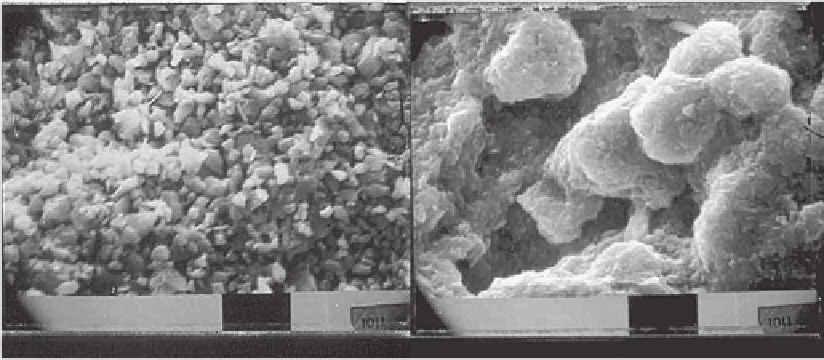Environmental Engineering Reference
In-Depth Information
calculated wetted surface areas
S
w
for the soils shown in Figure 10.6 show that the wetted
surface areas vary from about 3% to 7% of the speciic surface area of the soils. This indicates
that microstructural units such as those shown in Figure 10.3 encompass a large number
of soil particles, to the extent that the effective surface areas presented to a contaminant
leachate stream represents only a small fraction of surface areas present. For soils that are
prepared for use as barriers and liners, the sizes and distribution of microstructures are sig-
niicant factors in determining the effectiveness of the barriers and liners.
10.5.1.2 Microstructure, Wetted Surfaces, and Transport Properties
Hydraulic conductivity through a soil engineered barrier is greatly facilitated when intercon-
nected voids and their connecting channels are large. Large voids in a compact soil generally
mean large grain sizes and/or large microstructural units. In addition to the advantage of
larger low paths, large interconnected voids generally mean that the surfaces presented as
the surrounding surfaces in the void spaces are lesser than if the void volumes were smaller.
The surrounding low path contact surfaces are important factors because they (a) offer drag
or boundary resistance to low, and more importantly (b) provide the surface areas and cor-
responding functional groups for chemical reactions that include sorption, ion exchange,
and complexation. We will discuss this latter aspect in detail in the next section.
Figure 10.7 shows two scanning electron micrographs of the same clay soil. The clay
soil was obtained as a core sample from a recently cut slope in northern Québec, Canada,
Width of black
band is 10 μm
Same clay soil sample after 32
cycles of freeze-thaw. Note
development of large
microstructural units
Natural clay soil before
freeze−thaw cycles
FIGURE 10.7
SEM picture showing formation of large microstructural units in a natural clay soil after 32 cycles of freezing
and thawing.




Search WWH ::

Custom Search